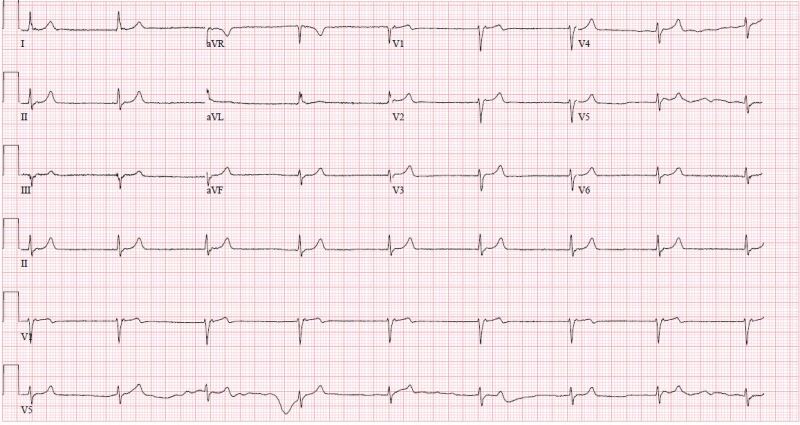Junctional Rhythm
Important Points in ECG
- Heart Rate: Typically ranges between 40 to 60 beats per minute (bpm), although it can vary.
- P Wave: Absent or inverted if present, as the impulse may originate from the AV node or below it.
- R-R Interval: Irregular due to the absence of a consistent SA node input.
- QRS Complex: Usually normal unless there’s an underlying conduction abnormality.

What is Junctional Rhythm?
Junctional rhythm is a cardiac condition characterized by the abnormal initiation of electrical impulses within the atrioventricular (AV) junction, leading to a distinctive heart rhythm. In this condition, the heart’s electrical activity originates from the AV node or its surrounding tissues, bypassing the normal pathway originating from the sinoatrial (SA) node.
Causes of Junctional Rhythm
- Dysfunction of the SA Node: Dysfunction or suppression of the SA node can prompt the AV junction to take over as the primary pacemaker.
- Cardiac Diseases: Conditions such as ischemic heart disease, myocarditis, and cardiomyopathies can disrupt normal electrical conduction.
- Electrolyte Imbalance: Abnormal levels of potassium, calcium, or magnesium can interfere with the heart’s electrical activity.
- Medications: Certain drugs like beta-blockers, calcium channel blockers, and digitalis can influence AV node function, potentially leading to junctional rhythm.
Types of Junctional Rhythm
Junctional rhythm can manifest in several forms, each with distinct characteristics and implications for cardiac function. Common types include:
- Accelerated Junctional Rhythm: In this type, the heart rate is elevated, typically ranging from 60 to 100 beats per minute (bpm). Despite the increased rate, the rhythm originates from the AV junction, leading to a narrow QRS complex on the ECG.
- Junctional Escape Rhythm: Occurring when the SA node fails to generate impulses or when its signals are blocked, a junctional escape rhythm involves the AV junction taking over as the primary pacemaker. Heart rate in this rhythm is typically slow, ranging from 40 to 60 bpm, with a regular rhythm and narrow QRS complexes.
- Junctional Tachycardia: Characterized by a rapid heart rate exceeding 100 bpm, junctional tachycardia originates from the AV junction. Unlike other forms of junctional rhythm, tachycardia results in a fast and often irregular rhythm on the ECG.
- Nonparoxysmal Junctional Tachycardia: This type of junctional tachycardia presents as a sustained, regular rhythm with heart rates ranging from 100 to 150 bpm. It may occur in the absence of underlying heart disease and is often related to enhanced automaticity of the AV junctional tissues.
Symptoms of Junctional Rhythm
- Palpitations: Sensation of irregular or forceful heartbeats.
- Fatigue: Due to inefficient cardiac output.
- Dizziness or Syncope: Resulting from decreased blood flow to the brain.
- Shortness of Breath: Especially with exertion due to reduced cardiac output.
ECG
- Absence or Inverted P Wave: Reflecting retrograde atrial depolarization or its absence.
- Narrow QRS Complex: If the impulse originates close to the ventricles.
- PR Interval: Shortened or absent, reflecting the close proximity of the AV node to the ventricles.
- Irregular R-R Interval: Due to the variable nature of AV junctional rhythm.
Treatment :
- Medications:
- Atropine: Used in acute cases to increase heart rate by blocking vagal stimulation.
- Isoproterenol: A beta-adrenergic agonist used to increase heart rate and improve conduction through the AV node.
- Calcium Gluconate: Administered in cases of electrolyte imbalance to restore normal calcium levels, which can affect cardiac conduction.
- Other Treatment Options:
- Temporary Cardiac Pacing: Implemented in emergent situations to stabilize the heart rate and rhythm until definitive treatment can be initiated.
- Definitive Treatment: In cases where junctional rhythm persists or recurs, identification and treatment of the underlying cause are crucial. This may include addressing electrolyte imbalances, managing cardiac diseases, or adjusting medications that may be contributing to the arrhythmia.
Complications:
- Heart Failure: Reduced cardiac output over time can lead to heart failure.
- Thromboembolism: Risk of blood clots due to stagnant blood flow in the atria.
- Syncope: Sudden loss of consciousness due to inadequate blood flow to the brain.
References:


Pingback: common health conditions - Health Google